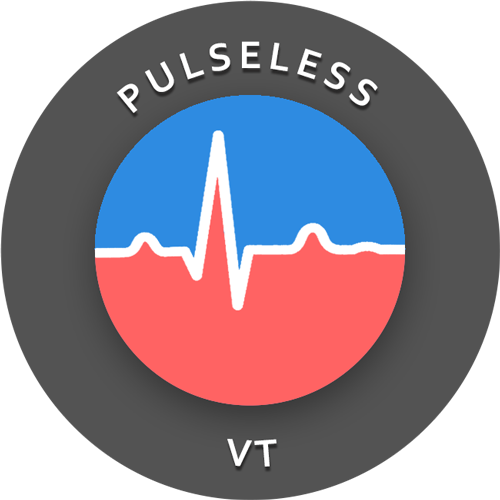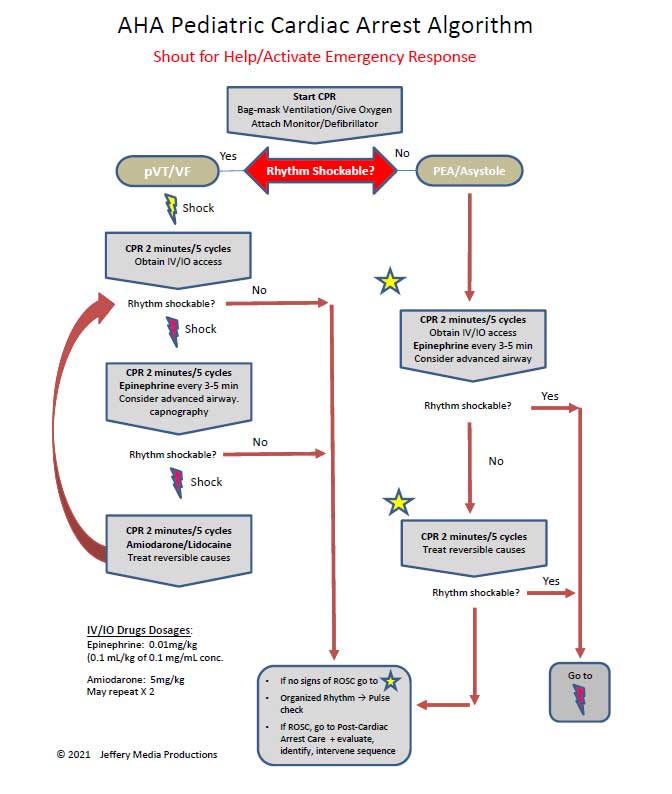
The pulseless ventricular tachycardia rhythm is primarily identified by several criteria. First, the rate is usually greater than 180 beats per minute, and the rhythm generally has a very wide QRS complex.
Second, the patient will be pulseless. And third, the rhythm originates in the ventricles. This is in contrast to other types of tachycardias which have origination above the ventricular tissue (in the atria).
Not all ventricular tachycardias are pulseless, and therefore, pulselessness must be established prior to beginning an algorithm. This is accomplished simply by checking a carotid or femoral pulse.
Pulselessness with a tachyarrhythmia occurs because the ventricles are not effectively moving blood out of the heart and there is, therefore, no cardiac output. Many tachyarrhythmias of a rate >150 will deteriorate into pulselessness if timely treatment is not given.

Pulseless ventricular tachycardia is treated using the left branch of the cardiac arrest algorithm. Click below to view the cardiac arrest algorithm diagram. When finished click again to close the diagram.
Cardiac Arrest Diagram

Click to view, and click again to close the diagram.
PALS Cardiac Arrest Diagram

Play the video below to see what a Pulseless Ventricular Tachycardia will generally look like on a defibrillator monitor. Allow several seconds for video to load. (4.03 mb)
Click for next Rhythm Review: Ventricular Fibrillation
Top Questions Asked on This Page
-
Q: What happens after the 2nd dose of Amiodarone is given and the patient is still in the same rhythm? Do we give a 3rd dose immediately or rhythm usually changes after 2nd dose?
A: A 3rd and even a 4th dose of 150 mg amiodarone may be administered. The only thing that needs to be taken into consideration is the 2.2-gram maximum dosage for 24 hours. Also, it is unlikely that the rhythm will remain VF or pVT long enough for you to get to the 3rd or 4th dose.
-
Q: What does refractory VT or VF mean?
A: Refractory pVT or VF means that the VF or pVT does not convert to a perfusing rhythm and continues to persist in spite of multiple attempts at conversion with defibrilation, acls drugs, and high quality CPR.
-
Q: After initiating CPR and assessing the rhythm, the patient is in VF/ pVT and the first shock is given, and CPR for 2 mins. Then rhythm check and in VT, should the pulse be checked to confirm pVT?
A: If there is no rhythm change and the same waveform of VT continues, you would not need to perform a pulse check. Performing the pulse check would delay the continuation of chest compressions. Once VT is pulseless it is very unlikely that any VT will be able to produce life-sustaining cardiac contractions.
Flanagan Whitsitt says
What is up with the music. I absolutely can’t stand it. I am not here to be entertained. I can go to Netflix for that.
I am here to learn ACLS and to further my knowledge of fatal rhythms. Perhaps I am just to wound up. But Having to listen to your suspenseful music does not make this a more pleasant, learning experience for me. It would be preferable if you there was a “Turn music off option” for those that dont want to listen to it.
J. Queen says
There is a volume control. Just turn it down until you can no longer hear it.
jhart46n@aol.com says
On the defibrillator monitor, there is a speaker icon to “turn off the music”
Mlandeli J Ncube says
Quite helpful. I enjoyed and benefited a lot from this.
Elaine says
Thank you so much for all that you do. My AC LS class was on August 30 my score a 92 the best 92 I’ve ever had thank you thank you thank you, it has been a pleasure using your site. You give so much of yourself and I hope you get a lot out of our comments we truly mean it ,thank you!
SH says
Why does pulseless ventricular tachycardias has wide qrs complex? To my knowlegde it should have a narrows qrs complex since ventricular is contracting fast.
ACLS says
The reason why pulseless ventricular tachycardia has a wide QRS complex is because the electrical impulse for the QRS complex is being generated in the ventricle rather than the atrium. As a result electrical depolarization is slowed and not moving through the normal pathway of the heart. This causes the QRS complex to be wide.
Kind regards,
Jeff
Diego Moctezuma says
Out of 1000 VT how many are pulseless?
ACLS says
I do not have any idea what the answer to that question is. My guess would be there are many more cases of ventricular tachycardia with a pulse. In my 25 years of nursing experience I have seen many instances of ventricular tachycardia with a pulse and only a handful of pulseless ventricular tachycardia.
Kind regards,
Jeff
Christina Johnson says
I have re-certification this weekend for all three and this is a God-send! Thanks so much for this!!
ACLS says
Hi Christina,
Thanks so much for the comment. Good luck with the upcoming class!
Kind regards, Jeff
Suzanne Watson says
Are defibrillate & shock the same thing?
ACLS says
Yes. Those terms are often used interchangeably. Defibrillate or defibrillation would be the better term to use. It’s more specific than just saying shock.
Conversely, Usually when synchronized cardioversion is taking place that word will be used rather than just saying “shock.”
Kind regards,
Jeff
Derek Longoria says
As a paramedic say I come across the following scenario …
Pulseless pt, I start doing CPR, BVM with O2 and then I put the defib padz on the pt. At this time should I also place a 4 lead or wait until I possibly get ROSC for the 4+12 lead?
Thanks a lot this site is awesome!
ACLS says
You should wait until ROSC is achieved before you attempt to obtain an ECG.
Dealing with cardiac arrest with the goal of obtaining ROSC is the most important issue. PlACE the defibrillation pads, perform rhythm analysis, and defibrillation as soon as possible.
Kind regards,
Jeff
Moraa says
After how long should we wait to give 2nd dose of Amiodarone?
ACLS says
You would wait long enough for the first dose of amiodarone to reach and have an effect within the central circulation. This would usually be at least two minutes of high-quality CPR.
The second dose of amiodarone can typically be given anytime after the fourth shock.
Kind regards,
Jeff
SUDHIR DEY says
Very clear understanding. All my previous doubts are getting cleared. Thanks.
Angelika Milana says
Love reading “Top Questions Asked on this page”, alway very helpful info! Thank for your wonderful class, this is my third time in a row using it. Your the best!
Angelika
Sylvia Garey says
I have a clearer understanding now.
EDWARD TRENTACOSTA says
WOW, EXCELLENT QUEST AND ANSWERS, VERY WELL EXPLAINED.
Marcia Bailey says
Thanks a million for this website. It is truly helping to increase and improve my knowledge.
arianne orencia says
very helpful..
Trudy says
Very good ,
It is very precise and at the same time educative . It deliberates on all the important points not beating about the bush .
Thanks again .